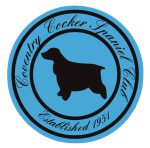A merry, sturdy, sporting dog with a gentle and affectionate nature.

The Cocker Spaniel is by far the most popular of all the spaniel breeds. Cockers were originally used as gundogs to flush, quarter and retrieve small game birds. The size, appearance and temperament of the breed make cockers very appealing pets. Cockers come in a wide variety of colours, black, golden and blue roan being the most popular but orange and white, orange roan, black and tan, liver/chocolate, liver/chocolate roan, liver/chocolate and white and black and white are also seen. The beautiful coat does have drawbacks as regular grooming and trimming is required.
The BREED STANDARD for a cocker calls for a merry, sturdy, sporting dog with a gentle and affectionate nature. The size range is 15 to 16 inches to the withers with a weight of 28 to 32 pounds. The full Kennel Club BREED STANDARD can be found HERE. As with most breeds, cockers can have hereditary kidney and eye problems. For this reason breeding stock should be eye tested and there are now genetic tests to identify carriers of FN and PRA. The Kennel Club and the British Veterinary Association collate the results of screening tests. Joint problems can occur but they are not as prevalent as they are in larger breeds of dog. A cocker is usually a very healthy dog with a lifespan of 11 to 14 years. Click HERE for a downloadable fact sheet about COCKER SPANIEL HEALTH (pdf file)
Cockers are very adaptable and they will fit in with any life style but they cannot be left alone for long periods. As with any dog they can become distressed and destructive if they are left to their own devices for too long. They always seek human companionship.
Once a puppy has been obtained from a reputable breeder the hard work really starts. The puppy should be checked by a vet and given his initial vaccination against common canine diseases. Puppies also need to be wormed regularly and checked for signs of fleas or lice. Ears need be kept clean and canker free. The puppy should come with a diet sheet and this must be adhered to, sudden changes can affect the digestion. The puppy will need a safe place to sleep and eat. Some people use a puppy pen or cage to give the puppy his own space. Cocker puppies look adorable but they are intelligent dogs so they must know their place in the family. Never let children pick up or tease a puppy. Toys should be chosen with care, cockers love to retrieve but never play tug of war games with them. If games get out of hand calm things down and put the puppy back in his own space.
Once a cocker puppy has finished his course of inoculations he can start to go out for short trips in the car but keep him in a cage or behind a dog guard. Travel sickness can occur but puppies soon get to love the car. Walks on the lead should be kept very short until he is fully grown. Flexi-leads are useful to give the dog freedom but give the owner control. Puppy socialisation and training classes are very helpful but go to watch one first to make sure it is well run. Many clubs follow The Kennel Club Good Citizen Dog Scheme and dogs can progress from The Puppy Foundation to Gold. Cockers also enjoy agility and gundog training but don’t expect a show bred cocker to become a full time working gundog.
The cocker coat is beautiful if it is kept in good condition. From the start get him used to standing on a table to be groomed. Check his teeth and ears regularly. The puppy coat can be groomed with a comb and a slicker brush. Trim the hair under his ears with thinning scissors. The same scissors can be used to trim the hair from the throat and under the tail. Straight hairdressing scissors are used to trim the feet. The hair should be cut level with the pads underneath and then the hair should be trimmed from around the feet to give the desired ‘cat like’ appearance. The feathering on the legs is trimmed to make it more manageable.
Some time between 6 and 9 months the puppy coat will be ready to come out. With the puppy standing on the table with his back end to you, pull a fine comb through the coat on his neck and back. The hair on the top of the head should be removed using the finger and thumb method. Latex gloves will give more you grip. Some people prefer to take their dog to professional groomers. These mostly use clippers on the coat, this will make the hair grow back thick and woolly. Cockers can still look smart when they are clipped but they need to be done at least every 12 weeks. Neutering makes the coat revert back to a puppy coat and clipping is the only option. Ask your breeder to recommend a good groomer in your area or perhaps she/he will trim the puppy for you. If you intend to show your puppy, look at cockers in a few shows and ask for help. Cocker Spaniel Breed Clubs often run grooming seminars. More information on TRIMMING can be found HERE
